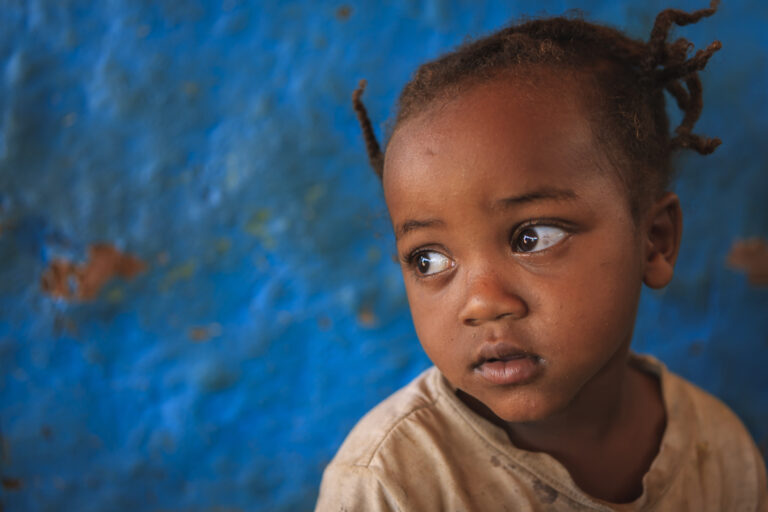Venezuelan Women’s Groups Promote Population Control
The Venezuelan family planning association, PLAFAM, received a grant from the Jessie Smith Noyes Foundation to strengthen organizational ties with women’s organizations. PLAFAM has now joined forces with the Venezuelan Children’s Foundation (CF), which is led by the country’s First Lady. The Children’s Foundation, originally founded for the well-being of children, is currently involved in a series of activities to promote the advancement of women.”
With the Noyes Foundation grant, PLAFAM also conducted seminars for women enrolled in sewing classes organized by the Venezuelan Children’s Foundation. The seminar, entitled “The Advancement of Women and Family Planning,” was held in Maracay, in the rural province of Aragua. It was designed to show how the use of abortifacients and contraceptives can help women play a more active role in Venezuelan society. Seminar participants were encouraged to become volunteers for PLAFAM, promoting population control methods in their own communities.1
Another group funded by the New York-based Jessie Smith Noyes Foundation in Venezuela is the Asociacion Venezuelana Para Una Educacion Sexual Allernativa ($35,000).2
Internationally, the Noyes Foundation funds abortion rights groups such as the Women’s Global Network for Reproductive Rights, the Alan Guttmacher Institute, Catholics for a Free Choice, and the National Abortion Rights Action League.3
Induced Abortion in Europe:
Planned Parenthood in Europe reports that although legal regulations are important, the actual practice of abortion is also determined by non-legal factors.
The attitude of the medical profession is a determining factor since abortion services can never be satisfactory if doctors do not want to cooperate. A short-term solution for this problem has been the creation of specialized abortion clinics, where doctors could perform abortions without being criticized. This is the basic reason for the existence of specialized clinics, which are found in England, the Netherlands and in some parts of Germany.
In Roman Catholic countries or regions, such as Spain, Italy, Austria, and the southern part of Germany, the majority of doctors object to abortion. In France and Italy, where clinics would be a good solution, the governments do not allow them.
The attitude of society at large regarding abortion is also of major importance. If abortion is a taboo subject, as in Switzerland, Austria, southern Germany, or Belgium it becomes very difficult to mobilize the population.4
World Bank Initiative
The population component of developmental and environmental protection is emphasized in two recent reports by the World Bank. The first, titled “Women in Development: a Progress Report on the World Bank Initiative,” points out that increasing women’s productivity and earning potential will “over time …help slow population growth.”
The second study asserts that population is a target of the World Bank’s three-year action agenda for combating environmental degradation. The 112-page report, The World Bank and the Environment: First annual Report, Fiscal 1990, explains that 3 the thrust of the action plan adopted in 1989 was to integrate environmental concerns into the Bank’s development agenda. A major objective of the program is to increase lending for population and environmental projects.
Mexico: Population Control “Pragmatism”?
Population Communications International reports that: “Pragmatism underpinned by a sound philosophical foundation is working demographic wonders among Mexico’s underprivileged.” The achievements are described as the work of the Federacion Mexicana de Asociaciones Privadas de Planificacion Familiar (FEMAP).
The genesis and accomplishments of FEMAP, a non-governmental organization (NGO), were explained by two of its senior officials — Guadalupe de la Vega and Lorenza Vildosola.
Mrs. de la Vega is the founder and national president of FEMAP, whose headquarters is in Ciudad Juarez. Mrs. Vildosola is the organizations director in Mexicali. Started by Mrs. de la Vega in 1973 (a full year before the Mexican government inaugurated its national family planning program), FEMAP has since spread in the form of autonomous affiliates to nearly 70 cities, towns, and rural areas throughout Mexico.”
Staffed by “coordinators, promoters, and field workers,” FEMAP’s programs run on the idea that “family planning is a means p of personal empowerment for women, which leads both women and their families into better lives.” FEMAP has been financed by the International Planned Parenthood Federation (IPPF) as well as by the U.S. Agency for International Development s (USAID). Mrs. de la Vega said that her program expects to receive financial backing from the Mexican government, pointing out that the president, Carlos Salinas de Gortari, supports the work and goals of FEMAP.5
JHU/USAID Population Sampler:
USAID “Yellow Book” (Current Technical Service Contracts and Grants Active, Oct.1, 1987 through Sept.30, 1988):
- Contract 620-0001-C8013-00; Johns Hopkins University (JHU), “Mission” (overseas/ Nigeria), Population Communication Services, Registration/Purchase Request; Project No. 620-462-3- 7001, Effective date March 15, 1988 between REDSO/WCA, c/o American Embassy Cote d’Ivoire and Johns Hopkins Population Communication Services, estimated cost of this contract is $14,998,497 . This amount is part of approximately $67 million obligated for Family Health Services Initiatives, Nigeria.
- Contract 620-0001-C-00-8013-00; USAID/Nigeria Family Planning information, Education and Communication (IEC) action programs; 03/22/1988 — 03/14/1993; $6,530,000.
- Contract DSPE-CA-0083; JHU JHPIEGO Corporation; For education in Reproductive Health, $44,028,000 .
USAID “Yellow Book” (current Technical Service Contracts and Grants Oct. 1, 1988- Sept. 30, 1989) :
- Contract DPE-3004-A-00-6057-00; World-wide, JHU shall provide Family Planning Services and Education on Contraceptive Services, 08/29/1986-08/31/1991, $40,729,190.
- Contract DPE-3032-Z-00-7061-00; JHU Shall Assist in Improving Less Developed Country (LDC) Population Policy Decision-Making, 08/31/87-08/30/1992, $8,816,143.
Bangladeshi Sterilization Incentives:
Studies in Family Planning reports that: “The successive governments of Bangladesh, like those of India, have shown a serious and sustained commitment to the reduction of population growth.”
In that interest, a system of compensation payments was begun in 1976, and the sums to clients were increased from about Taka 100 to Taka 175 in October 1983. Today, Taka 175 (the equivalent of about US$5.50) represents a week’s earnings for an unskilled rural laborer without food. In addition, female patients are provided with a saree and men with a lungi .
A monthly target of two sterilization cases and one IUD case per month was established for each “family welfare” worker. The emergency program brought about a surge in the number of vasectomies performed and IUDS inserted.
Pondering the strategies involved, the authors of this report concede that: “Perhaps extreme poverty, as well as rising living standards and aspirations, can act as powerful motives for reduction in family size. Alternatively, it can be argued that the decline is primarily the result of a government program that has placed excessive and unfair pressure on individuals.”
It is further noted that: “Side-effects are commonly reported by patients who have been sterilized (Rahman et al., 1984), and the case-control study indicates that a minority spend rather large sums on medical care .… We accept that fear and to some extent shame may deter individuals from contraceptive sterilization in Bangladesh, but reject the view that this should invoke financial compensation, not least because it would be impossible in practice to distinguish from outright inducement to people to sacrifice their reproductive rights.”
In closing, the authors estimate that the average sterilization client has a small positive balance from the cash compensation. Although, “The profit may seem far too trivial to act as an inducement for a lifetime decision .… the possibility cannot be dismissed when the sum involved is set against the extreme poverty and daily struggle to survive of much of the population.”6
U.S. AIDS Deaths
By the end of 1990, almost 10 years after the first AIDS-related death became known to the Centers for Disease Control, more than 100,000 Americans have died as a result of AIDS and human immunodeficiency virus (HIV) infection; about one-third of these deaths occurred in 1990 alone. Overall, 90 percent of all AIDS-related deaths so far have occurred among men. Fifty-nine percent of all AIDS-related deaths have been among homosexual or bisexual men who were not intravenous drug users, while 28 percent have been among users of intravenous drugs. Among the latter, 21 percent were women and heterosexual men and seven percent were homosexual and bisexual men. Of all deaths, 55 percent have been among white non-Hispanics, 28 percent among black non-Hispanics and 16 percent among Hispanics. Seventy-three percent of deaths have been among 25-44 year olds, almost equally divided between 25-34-year-olds and 35-44 year olds. It is estimated that 165,000-215,000 more Americans will have died of HIV-related causes by 1993.7
Czechoslavakian Contraceptive Strategy
Government recognition of population control is not legally or otherwise specified in Czechoslavakia. The constitution does not include a reference to family planning. However, the sale and distribution of contraceptives is not forbidden by law.
All contraceptives (oral, IUDs, diaphragms, spermicides and caps) are available free of charge but condoms are not. There are no legal restrictions on the advertisement of contraceptives. Sterilization is legally permitted only for medical reasons for both women and men.
Legal abortion is available up to 12 weeks of pregnancy; abortion up to eight weeks is provided without charge, but after eight weeks an additional payment of 500 Kcs is required. The performing physician is obliged to inform the woman of possible side-effects of the operation and to provide contraceptive advice.
The abortion rate has increased from 6.5 (per 1000 total population) in 1980 to 10.2 in 1988, equaling 75 induced abortions per 100 live births. Availability of contraceptives is no longer a real problem. IUDs are manufactured in Czechoslavakia and exported.
Major priorities of birth control promoters include the establishment of family planning clinics. At present gynecologists hold a monopoly of advice in contraception. Many of them are said to be “moralizing” in their reaction to younger women’s requests for contraception.
Contraceptive advocates encourage the prescription and use of both hormonal contraceptives and condoms and abortifacient/contraceptive services for adolescents and students. They are committed to obtaining government funding for population control methods, and the widespread promotion of public information about abortifacients and contraception through leaflets and discussion in the mass-media.
A movement for the protection of unborn life has recently been established. It has received financial support from the Government. Endless polemics about the problem of the very beginning of human life have been generated.
Many ideological opponents of family planning stress that the liberal abortion law is a relic of the monopoly of the Communist Party.
The ‘gentle revolution’ strengthens the position of the Christian Churches. Their influence on sexual morality seems to become stronger, especially in the Slovak Republic.8
Sterilization in Puerto Rico:
Puerto Rico may have the world’s highest rates of sterilization, according to the 1982 Fertility and Family Planning Assessment.
The 3.3 million inhabitants of this Caribbean island, a commonwealth associated with the U.S., are primarily Spanish speaking, and a majority are Roman Catholic. In a 1982 survey, 41 percent of the married women had been sterilized to Prevent pregnancies, and another 4.6 percent had husbands who had been sterilized. Even more surprising, a sizable proportion of young women — 39 percent of married women aged 25-29 — opted for this type of “permanent” birth control, according to the survey.
Overall contraceptive use in Puerto Rico is high. Sixty-nine percent of married women were using some form of birth control in 1982. However, female sterilization accounted for 58 percent of overall birth control use in Puerto Rico, compared to only 26 percent in the U.S.
Widespread sterilization among younger women and women with only two or three children has had a major impact on the Puerto Rican birth rate, which declined from 33 to 20 from 1960 to 1986. An estimated 33 percent of the decline in marital fertility between 1977 and 1982 has been attributed to the level of sterilization.9
India’s Lost Women:
In India, the 1981 census records show that for every 1,000 men there are 933 women. In 1901 the ratio was 972 women for every 1,000 men. It would appear that the country’s sex ratio that has been deteriorating throughout this century.
World press Review presents this information as a “disparity” which has resulted from “a conscious bias in favor of the male and against the female.”
The ideology of technology has added “its own contribution to the oppression of women .… All over India, amniocentesis, which was created to detect abnormalities in fetuses, is being used to discover the gender of the unborn child; if it is a girl, an abortion follows. In one hospital, a study showed, out of 8,000 abortions performed, 7,999 were female fetuses.10
Women in Development (WID):
UNITED NATIONS ; “Targets in fertility and family planning for the next decade are for the first time part of international development strategies .… Acceptability of (population control programs) is enhanced by promoting other human rights — economic security adequate housing and community services; education and health — by support for women’s social, educational and employment rights .…”11
U.S. AGENCY FOR INTERNATIONAL DEVELOPMENT ; USAID emphasizes the integration of women into the mainstream of development assistance. The organization’s comprehensive strategy in 1989 and 1990 focused on (p.13):
- Integration of gender considerations into the design and implementation in agriculture, private enterprise, education environment and natural resources.
- Institutionalization of women in development concern; through development of action plan, establishment of WID working groups, selection of WID officers, design and delivery of training programs, and information dissemination.
- Creation and management of a matching fund to stimulate investment in WID by USAID Missions and AID Bureaus.
- USAID projects also address the roles of women in health, population, nutrition, urbanization and legal rights.12
Child Prostitution in Thailand:
The promotion and commercialization of sex has led to a trend in child prostitution which is spreading to rural communities. A driving force which allows, urges or forces daughters to work in prostitution is described by Women’s International News as “yearning for a better material standard of living by parents who are not always the poorest of the poor.”
Girls who refuse to comply are regarded as ungrateful and irresponsible by both parents and neighbors. The solicitation of funds from prostitutes for community development projects by community leaders and teachers has legitimized the sale of children into prostitution even more.13
Endnotes
1 Forum, Vol. 7. No, l, “Noyes Foundation Grant, PLAFAM Strengthens Ties With Women’s Groups” (New York, International Planned Parenthood Federation Western Hemisphere Region, Inc., Jan 1991) p.8.
2 “Family Planning and Reproductive Health 1990/1991” [New York, The Foundation Center) p. 21.
3 Inventory of Population projects in Developing Countries Around the World 1988/1989 (New York, United nations Population Fund) p. 844.
4 Planned Parenthood In Europe, Vol.18, No. l (London, International Planned Parenthood, Spring 1989), p.3.
5 International Dateline, “NGO Insert,” (New York, Population Communication International, May 1990).
6 Studies In Family Planning, Vol.22, No.1, Jan./Feb. 1991, John Cleland and W. Parker Mauldin, “The Promotion of Family Planning by Financial Payments: The case of Bangladesh,” p.1.
7 Family Planning Perspectives, Vol. 23. No. 2, “The First 100,000 AIDS Deaths, March-April 1991. p.53.
8 Planned Parenthood in Europe, Vol.19. No. 2, “Family Planning in Czechoslovakia, After the ‘Gentle Revolution’,” p.17.
9 Population Today, February 1987, “Survey Report, Puerto Rico.”
10 World Press Review, April 1991, p.49.
11 Women’ International Network News, Vol.17, No. 3, Summer 1991, p.7.
12 Ibid., p. 13.
13 Ibid., p. 44.










